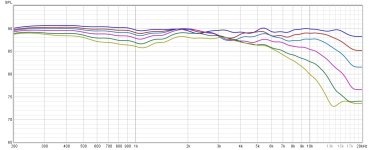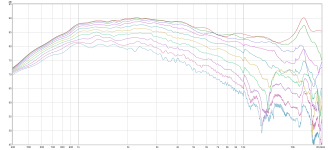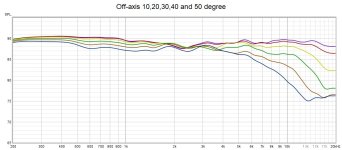Hi guys, there is a discussion about off axis measurement of my speaker over at hifijim thread "Purifi + Waveguide Project" and I feel I should start a new thread for the discussion rather than keep "intruding" Jim's thread further.
Attached is my off axis measurement and many have suggested, the 1.6-2kHz region has too much energy based on the off axis measurement and it will be good to bring it down by 1-2dB. If I understand correctly, when the speakers are placed facing straight, at the listening position it will be 15-30 degrees off axis from the speaker. With the 1-2dB reduction, the off axis response will be more "linear" and I believe the speakers will sound better. However, if we were to toe in the speaker facing the listening position on axis, with that 1-2dB dip between 1.6-2kHz, wouldn't that affect the sound quality? I believe one of the best alternative is to use a waveguide but given the condition, can we also adjust the speaker position to address the off axis issue?
Attached is my off axis measurement and many have suggested, the 1.6-2kHz region has too much energy based on the off axis measurement and it will be good to bring it down by 1-2dB. If I understand correctly, when the speakers are placed facing straight, at the listening position it will be 15-30 degrees off axis from the speaker. With the 1-2dB reduction, the off axis response will be more "linear" and I believe the speakers will sound better. However, if we were to toe in the speaker facing the listening position on axis, with that 1-2dB dip between 1.6-2kHz, wouldn't that affect the sound quality? I believe one of the best alternative is to use a waveguide but given the condition, can we also adjust the speaker position to address the off axis issue?
Attachments
A wonky off-axis response usually means your Room Interface Profile will be wonky too. This is known to be one of the most important characteristics of a speaker .. at least, if not more, important as Frequency Response @1m on axis bla bla.
If your crossover frequency is around 1.6-2kHz, you may want to move it up. But then the directivity of your bass unit may be too narrow so you might want a smaller one.
You want to match the directivity of bass & treble units at xover so there is a smooth transition even off axis. A properly designed waveguide can help.
If your crossover frequency is around 1.6-2kHz, you may want to move it up. But then the directivity of your bass unit may be too narrow so you might want a smaller one.
You want to match the directivity of bass & treble units at xover so there is a smooth transition even off axis. A properly designed waveguide can help.
Txn tweeter and Jantzen wg measurement is in the attachment.
https://pkaudio.webnode.cz/discovery10/
https://pkaudio.webnode.cz/discovery10/
Attachments
What I meant is comparing to before and after making the 1-2dB dip change to the original response curve... and why do you think facing the speakers straight forward will give good sound? For a start, it give terrible stereo.
Hi guys, there is a discussion about off axis measurement of my speaker over at hifijim thread "Purifi + Waveguide Project" and I feel I should start a new thread for the discussion rather than keep "intruding" Jim's thread further.
Attached is my off axis measurement and many have suggested, the 1.6-2kHz region has too much energy based on the off axis measurement and it will be good to bring it down by 1-2dB. If I understand correctly, when the speakers are placed facing straight, at the listening position it will be 15-30 degrees off axis from the speaker. With the 1-2dB reduction, the off axis response will be more "linear" and I believe the speakers will sound better. However, if we were to toe in the speaker facing the listening position on axis, with that 1-2dB dip between 1.6-2kHz, wouldn't that affect the sound quality? I believe one of the best alternative is to use a waveguide but given the condition, can we also adjust the speaker position to address the off axis issue?
I'd say it's 1.6 to 4 kHz, and it's from the baffle diffraction.
The best thing you can do use a baffle step simulator (VituixCad, Edge, Soundeasy, etc..) and figure-out a better placement for the tweeter relative to on and off-axis for both Horizontal AND Vertical. This usually involves moving the tweeter a bit off-center and considerably further away from the top edge of the baffle.
AFTER that is accomplished, then model the midbass driver in the same manner.
Once both are done model for a better crossover.
Note: you can go the waveguide route, BUT you generally need a larger waveguide to push the baffle diffraction effects (which are still present, but generally change amplitude and pass-band) to a lower freq.. I think ideally you are looking at something almost 8" in width and almost 5" in height to push the diffractive effects of a typical narrow baffle low enough to be useful.
You can also go the "absorptive" route by using a loose felt (like cotton denim re-bond) on the front of the baffle in various placements to achieve something similar.
Finally, you can also do substantial roundovers/bevels to the baffle edges, and or simply enlarge the baffle.
-and of course you can do some combination of the alterations above. A good combination is a real art - and when done well can provide excellent performance and look good as well.
Last edited:
You can try optimizing the crossover using the 40 degree axis. Often you can make an improvement here without changing the on-axis too terribly.
That is something most likely I will try out, lower the response by 1dB around the 2kHz region and see how much improvement I can get.@markbakk As a workaround, you could lower the level around 2,5k 1 to 2 dB. Most people seem to prefer a little less level there and the off axis bump compensates the power curve.
It’s cabinet/diffraction related.
You may have missed the earlier post Allen.
Our OP was wondering why his speakers didn’t have “meatier” vocals. Or lack of meat in the vocals. The OP can clarify. I, for one, was trying to translate what he meant.
Give us some measurements (graphical translation of auditory event) we said!
You may have missed the earlier post Allen.
Our OP was wondering why his speakers didn’t have “meatier” vocals. Or lack of meat in the vocals. The OP can clarify. I, for one, was trying to translate what he meant.
Give us some measurements (graphical translation of auditory event) we said!
Yup, this discussion started at Jim's thread and I mentioned the MR16P seems to have more texture in the vocal as compared to the TX woofer, however everything else the TX woofer is clearly the better driver. So I asked whether if the Purifi mid driver might be the answer to the best of both world.
Subsequently fellow members asked me to show the off axis measurement for better assessment of my crossover design. After some discussion, it seems the most workable solution is to adjust the output around the 2kHz region to improve the off axis of the speaker. So here I am asking for opinion on the new measurement.
Subsequently fellow members asked me to show the off axis measurement for better assessment of my crossover design. After some discussion, it seems the most workable solution is to adjust the output around the 2kHz region to improve the off axis of the speaker. So here I am asking for opinion on the new measurement.
.
Hi James. Yes that measurement is what I was visualising or thinking about.
In my own designs I will often sometime sacrifice a dip in the on axis response to get a smoother off axis response.
If I’m listening up close eg. 1m from the speaker, I may favour the a flatter response on axis response, despite the peaky off axis response.
In an ideal world you would have neither compromise. That can be achieved with a carefully designed 3 way, or a 2 way with a wave-guided tweeter to match the directivity at the crossover region. This latter approach then directs more of the tweeter towards the on axis; and reduces the off axis response at the highest frequencies.
Which may be an advantage, or disadvantage, depending on your room, or your listening preferences.
Now there are some new tweeters on the market with controlled directivity but maintaining a wide beam width out to 70 degrees. Some are DIY only. Some awaiting release to marketplace, AFAIK.
Still, the it’s not as wide as directivity of ribbon tweeters out to 90 degrees. But that’s another chapter I think…
Anyway, I think your ears and room and music will need to be the final arbiter. Let us know how it sounds to you!
Yup, this discussion started at Jim's thread and I mentioned the MR16P seems to have more texture in the vocal as compared to the TX woofer, however everything else the TX woofer is clearly the better driver. So I asked whether if the Purifi mid driver might be the answer to the best of both world.
Subsequently fellow members asked me to show the off axis measurement for better assessment of my crossover design. After some discussion, it seems the most workable solution is to adjust the output around the 2kHz region to improve the off axis of the speaker. So here I am asking for opinion on the new measurement.
Hi James. Yes that measurement is what I was visualising or thinking about.
In my own designs I will often sometime sacrifice a dip in the on axis response to get a smoother off axis response.
If I’m listening up close eg. 1m from the speaker, I may favour the a flatter response on axis response, despite the peaky off axis response.
In an ideal world you would have neither compromise. That can be achieved with a carefully designed 3 way, or a 2 way with a wave-guided tweeter to match the directivity at the crossover region. This latter approach then directs more of the tweeter towards the on axis; and reduces the off axis response at the highest frequencies.
Which may be an advantage, or disadvantage, depending on your room, or your listening preferences.
Now there are some new tweeters on the market with controlled directivity but maintaining a wide beam width out to 70 degrees. Some are DIY only. Some awaiting release to marketplace, AFAIK.
Still, the it’s not as wide as directivity of ribbon tweeters out to 90 degrees. But that’s another chapter I think…
Anyway, I think your ears and room and music will need to be the final arbiter. Let us know how it sounds to you!
Last edited:
- Home
- Loudspeakers
- Multi-Way
- Question about off axis measurements


